Virginia’s skies host a captivating array of hawks, eight distinct species soaring majestically across the state’s diverse landscapes.
Each hawk species contributes to the intricate ecological balance of Virginia’s ecosystems, from the formidable Red-tailed to the agile Cooper’s.
In this exploration, we delve into the fascinating world of these raptors, unveiling their distinctive features, hunting behaviors, and preferred habitats.
Witness the aerial prowess of the Broad-winged Hawk during migration and admire the Red-shouldered Hawk’s distinctive calls echoing through woodlands.
Understanding these magnificent birds provides a glimpse into Virginia’s wildlife diversity and an appreciation for the vital role hawks play in maintaining the delicate harmony of the state’s natural habitats.
8 Hawks of Virginia
Join us on a journey to discover the remarkable beauty and significance of the eight hawks that grace the skies of Virginia.
1. Sharp-shinned Hawk
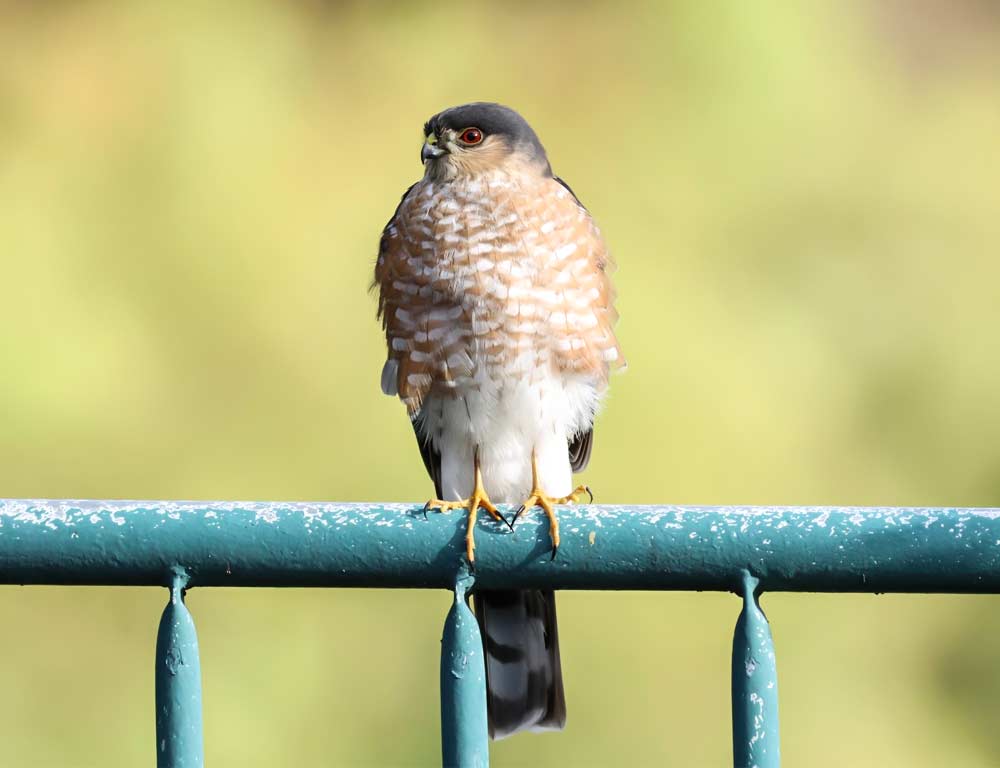
- Scientific name: Accipiter striatus
- Population: Stable
- Life span: 7 years (average)
- Size: 9 to 13 inches
- Weight: 3 to 7 ounces
- Food: Birds (especially songbirds), small mammals
- Wingspan: 16 to 22 inches
- Status: Least Concern
The Sharp-shinned Hawk, characterized by its short wings and long tail, is a stealthy predator in Virginia’s skies. With a stable population, these hawks exhibit a lifespan of around 7 years on average.
Their compact size, ranging from 9 to 13 inches, and a wingspan of 16 to 22 inches allow them to navigate dense forests with agility.
Sharp-shinned Hawks are skilled hunters, preying primarily on birds, especially songbirds, and occasionally targeting small mammals.
Their rapid flight and ability to weave through dense vegetation make them adept at ambushing their prey. Despite being widespread, habitat preservation remains crucial to sustaining their populations.
2. Cooper’s Hawk
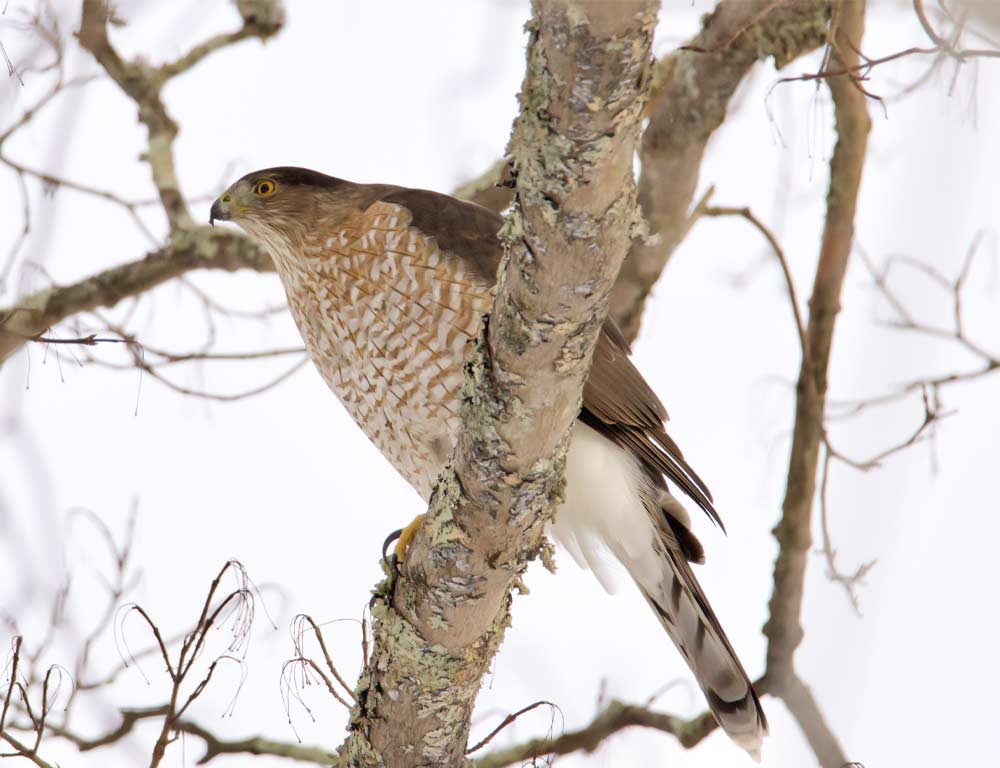
- Scientific name: Accipiter cooperii
- Population: Stable
- Life span: 7 to 10 years
- Size: 14 to 20 inches
- Weight: 7 to 24 ounces
- Food: Birds, small mammals
- Wingspan: 24 to 35 inches
- Status: Least Concern
The Cooper’s Hawk, with its distinctive long tail and short wings, is a versatile predator found in Virginia.
With a stable population, these hawks live an average of 7 to 10 years. Their size, ranging from 14 to 20 inches, and a wingspan of 24 to 35 inches enable them to navigate varied habitats.
Cooper’s Hawks primarily feed on birds and small mammals, displaying remarkable agility during pursuit flights. Their adaptability to urban and suburban environments contributes to their widespread distribution.
While their populations are stable, continued conservation efforts are essential to preserve their habitats and balance prey populations.
3. Northern Goshawk
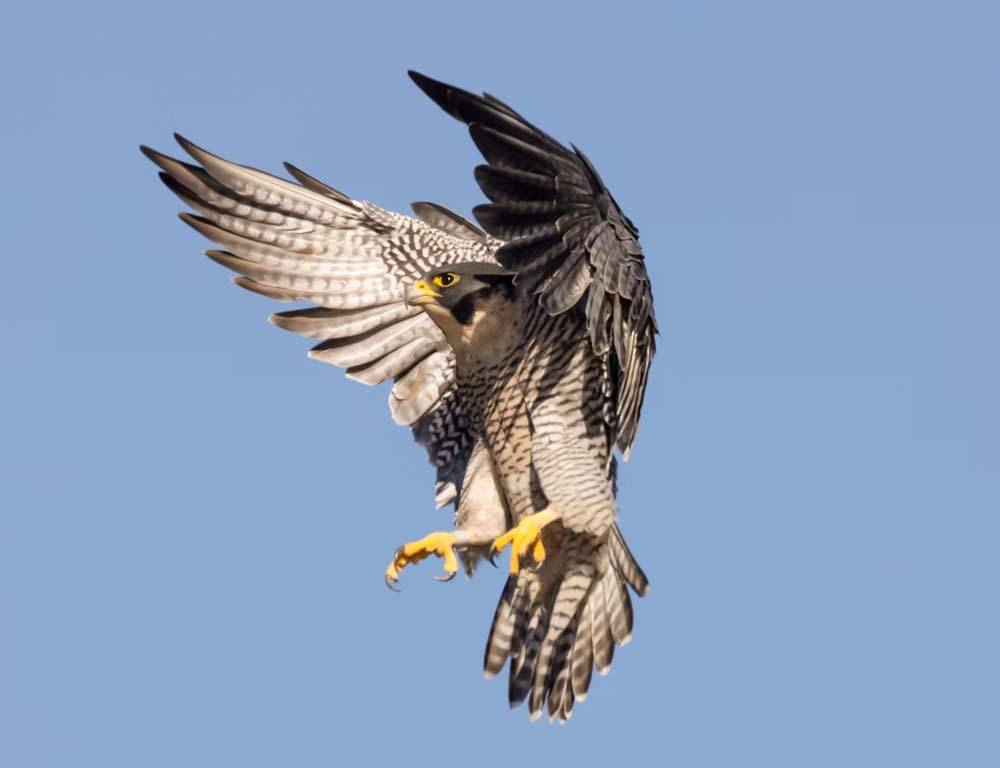
- Scientific name: Accipiter gentilis
- Population: Declining
- Life span: 10 to 20 years
- Size: 20 to 26 inches
- Weight: 22 to 48 ounces
- Food: Birds, mammals
- Wingspan: 40 to 46 inches
- Status: Near Threatened
The Northern Goshawk, a powerful forest-dwelling raptor, faces population decline in Virginia. With a lifespan of 10 to 20 years, these hawks are larger, ranging from 20 to 26 inches, with an impressive wingspan of 40 to 46 inches.
Northern Goshawks are formidable hunters, preying on birds and mammals. Their adaptability to diverse forested habitats, from coniferous to deciduous, underscores their ecological importance.
However, habitat loss and fragmentation pose significant threats, leading to their “Near Threatened” status. Conservation efforts focus on mitigating these challenges to safeguard the Northern Goshawk’s future in Virginia’s ecosystems.
4. Broad-winged Hawk
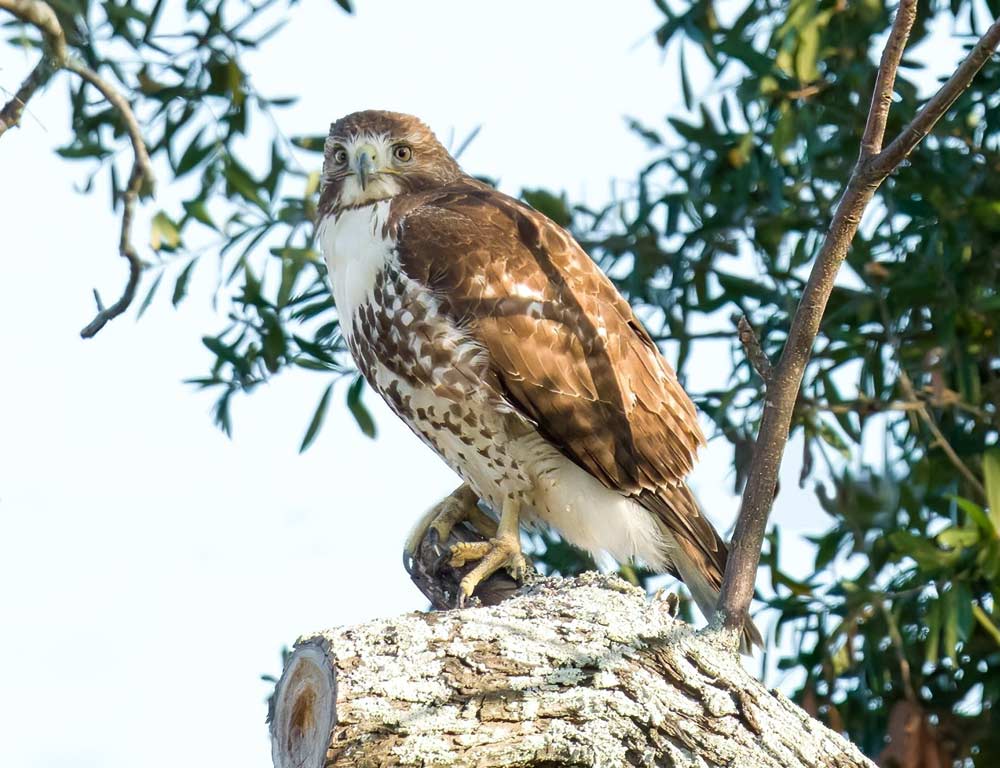
- Scientific name: Buteo platypterus
- Population: Stable
- Life span: 4 to 6 years
- Size: 13 to 17 inches
- Weight: 9 to 20 ounces
- Food: Small mammals, amphibians, reptiles
- Wingspan: 28 to 34 inches
- Status: Least Concern
The Broad-winged Hawk, recognized for its distinctive markings, is common in Virginia’s woodlands. With a stable population, these hawks have a 4 to 6 years lifespan.
Their medium size, ranging from 13 to 17 inches, and a wingspan of 28 to 34 inches facilitate their skilled maneuvering through forested landscapes.
Broad-winged Hawks primarily feed on small mammals, amphibians, and reptiles, using their sharp talons for efficient hunting.
They are known for their remarkable migratory behavior, undertaking long journeys to Central and South America during the winter.
Despite being widespread, preserving their forested habitats remains crucial for ensuring sustained populations.
5. Red-shouldered Hawk
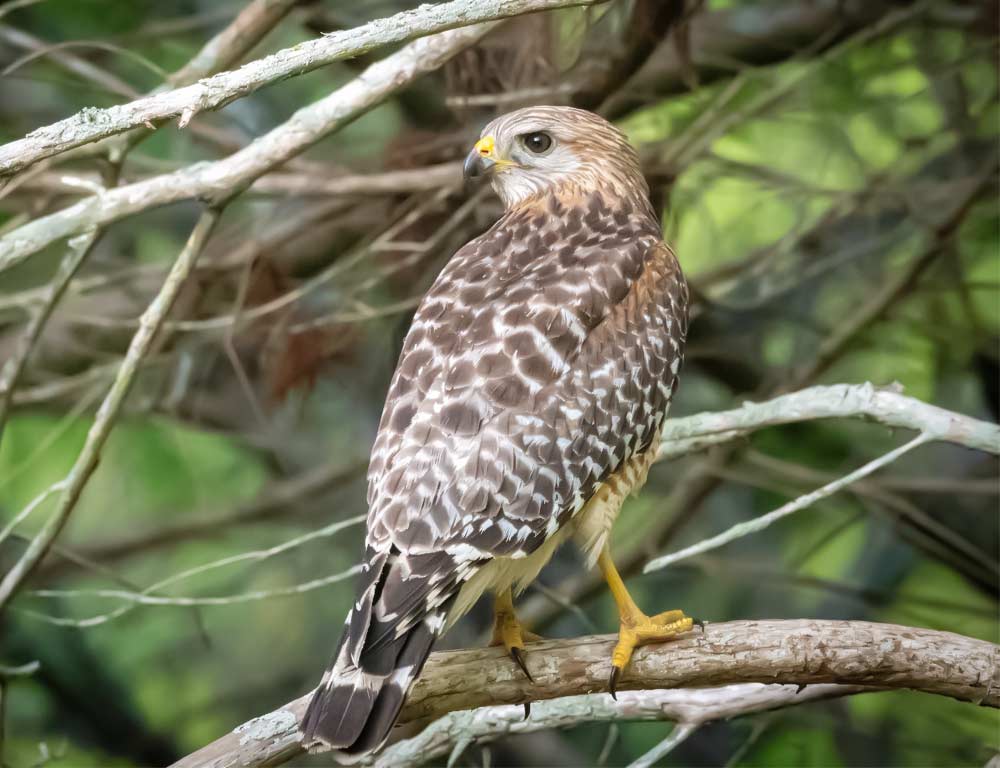
- Scientific name: Buteo lineatus
- Population: Stable
- Life span: 10 to 15 years
- Size: 17 to 24 inches
- Weight: 17 to 27 ounces
- Food: Small mammals, amphibians, reptiles
- Wingspan: 35 to 50 inches
- Status: Least Concern
The Red-shouldered Hawk, distinguished by its striking red shoulders, is a resident hawk in Virginia. With a stable population, these hawks exhibit a lifespan of 10 to 15 years.
Their larger size, ranging from 17 to 24 inches, and an impressive wingspan of 35 to 50 inches allow them to cover a diverse range of habitats.
Red-shouldered Hawks primarily feed on small mammals, amphibians, and reptiles, displaying skilled hunting techniques. Their loud and distinctive calls often resonate through woodlands.
While their populations remain stable, habitat preservation is crucial to sustain these majestic hawks, especially in riparian areas.
6. Swainson’s Hawk

- Scientific name: Buteo swainsoni
- Population: Stable
- Life span: 7 to 10 years
- Size: 18 to 22 inches
- Weight: 24 to 48 ounces
- Food: Insects, small mammals, reptiles
- Wingspan: 45 to 54 inches
- Status: Least Concern
The Swainson’s Hawk, known for its distinctive plumage and elegant flight, is a notable presence in Virginia. With a stable population, these hawks have a lifespan of 7 to 10 years.
Their medium to large size, ranging from 18 to 22 inches, and a wingspan of 45 to 54 inches make them efficient hunters in various habitats.
Swainson’s Hawks have a diverse diet, feeding on insects, small mammals, and reptiles. They are recognized for their impressive long-distance migrations, traveling between North and South America.
While their populations remain stable, preserving open habitats is essential to ensure the continued success of these migratory raptors.
7. Red-tailed Hawk
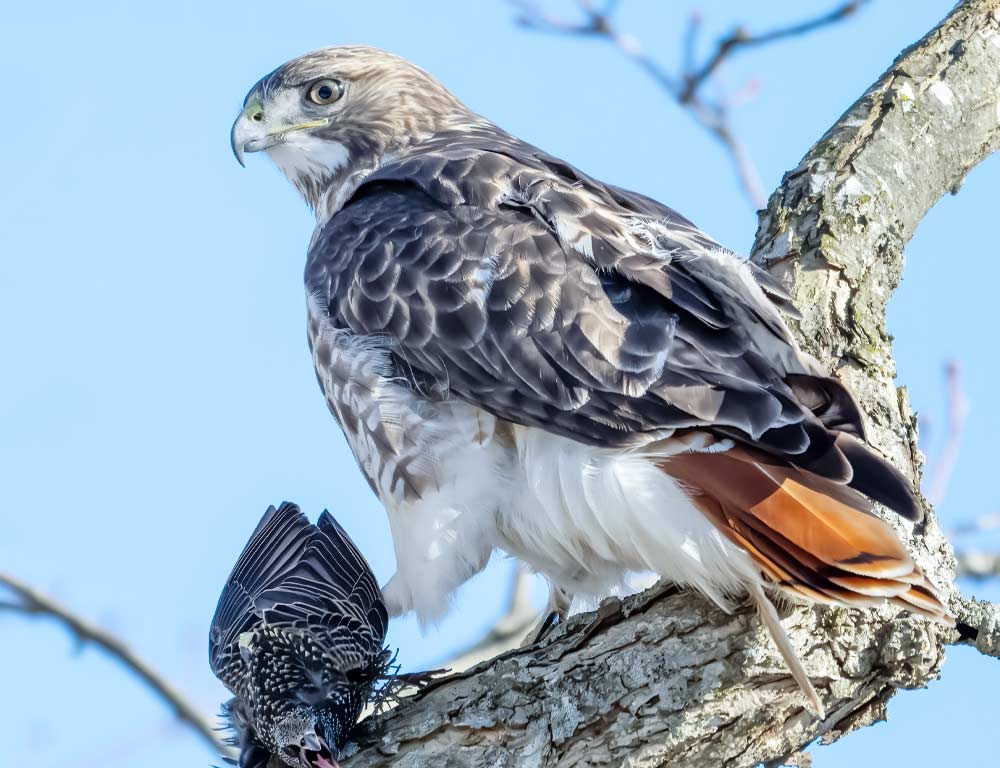
- Scientific name: Buteo jamaicensis
- Population: Stable
- Life span: 10 to 15 years
- Size: 18 to 26 inches
- Weight: 2 to 4 pounds
- Food: Small mammals, birds, reptiles
- Wingspan: 43 to 56 inches
- Status: Least Concern
The Red-tailed Hawk, an iconic raptor, graces Virginia’s skies with its broad wings and distinctive red tail. With a stable population, these hawks boast a lifespan of 10 to 15 years.
Their impressive size, ranging from 18 to 26 inches, and a wingspan of 43 to 56 inches make them one of the largest and most recognizable hawks in North America.
Red-tailed Hawks are versatile hunters, preying on small mammals, birds, and reptiles. Their adaptability to various habitats, from open fields to wooded areas, contributes to their widespread distribution.
While their populations remain stable, habitat conservation and protection are crucial for ensuring their continued presence in Virginia’s diverse landscapes.
8. Rough-legged Hawk
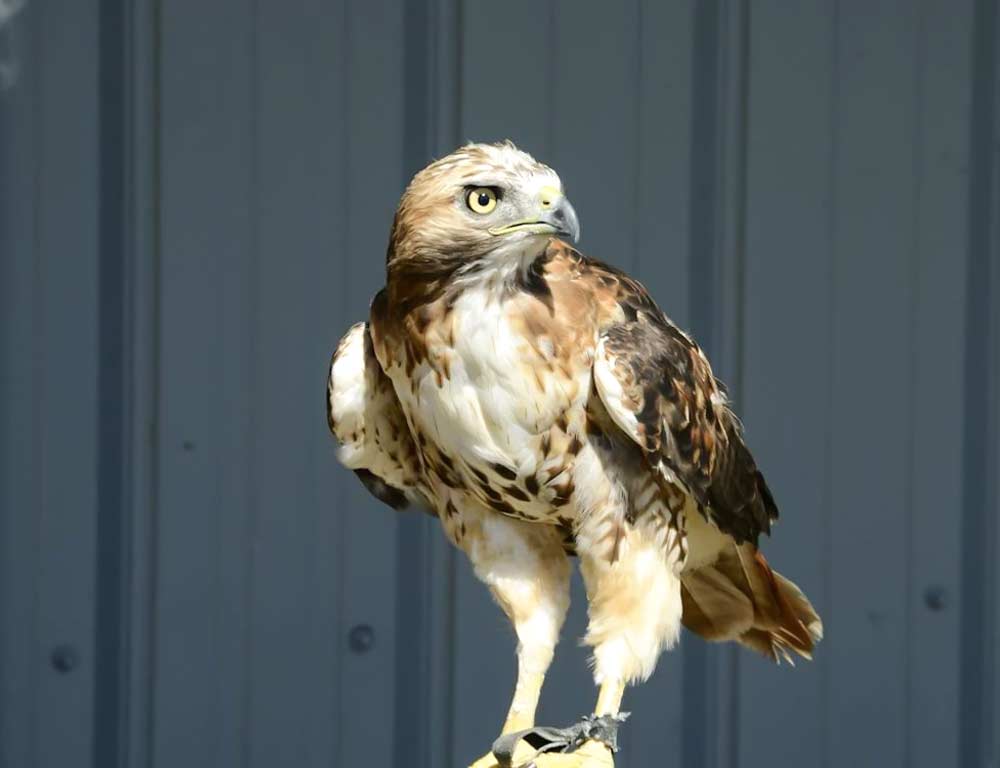
- Scientific name: Buteo lagopus
- Population: Stable
- Life span: 10 to 15 years
- Size: 18 to 24 inches
- Weight: 2 to 3.5 pounds
- Food: Small mammals, birds
- Wingspan: 52 to 54 inches
- Status: Least Concern
The Rough-legged Hawk, known for its feathered legs and adaptability to Arctic environments, is a winter visitor to Virginia. With a stable population, these hawks exhibit a lifespan of 10 to 15 years.
Their medium to large size, ranging from 18 to 24 inches, and a wingspan of 52 to 54 inches, make them well-suited for their nomadic lifestyle.
Rough-legged Hawks primarily feed on small mammals and birds, showcasing exceptional hunting skills. Their distinctive appearance and behavior make them a unique addition to Virginia’s winter avian residents.
Conservation efforts focus on preserving open habitats that provide suitable foraging grounds for these Arctic migrants during the colder months.
When And Where to Spot Hawks of Virginia?
Virginia, with its diverse landscapes ranging from coastal plains to mountainous terrains, offers a haven for birdwatchers seeking the majestic presence of hawks.
Observing these raptors in their natural habitat can be a rewarding experience, providing insight into their behaviors and the delicate balance they maintain in the ecosystem.
Here’s a guide on when and where to spot the hawks of Virginia.
Seasonal Migrations
Virginia witnesses remarkable hawk migrations during the fall and spring. Head to known migratory corridors, such as mountain ridges like the Blue Ridge, during September and October to witness the southward migration.
These hawks return northward in spring, March to May, making coastal areas and mountain lookouts ideal observation points.
Coastal Plains and Wetlands
Explore the coastal plains and wetlands during winter to spot hawks like the Rough-legged Hawk, which migrates south for the season.
Areas such as Chincoteague National Wildlife Refuge and Eastern Shore of Virginia National Wildlife Refuge provide excellent opportunities for observing wintering hawks.
Forested Regions
Venture into wooded regions, particularly during the late winter to early summer breeding season, to encounter species like the Red-shouldered Hawk.
Forests along the James River and Shenandoah National Park are prime locations where these hawks nest and display their impressive aerial acrobatics.
Open Fields and Grasslands
For species like the Red-tailed Hawk, known for their adaptability, open fields, and grasslands are preferred habitats.
The Great Dismal Swamp National Wildlife Refuge and rural agricultural areas offer expansive views and potential sightings of these soaring raptors.
Mountain Ranges
The Appalachian Mountains, especially the Blue Ridge and Alleghenies, serve as significant hawk migration routes.
Elevated vantage points along the Skyline Drive provide panoramic views during migration seasons. Look for thermals and updrafts that hawks utilize for efficient soaring.
Observing the hawks of Virginia requires patience, keen eyes, and an appreciation for the diverse ecosystems they inhabit.
By strategically choosing the right season and habitat, enthusiasts can immerse themselves in the awe-inspiring world of these magnificent birds of prey.
Wrapping Up
Embarking on a journey to witness the hawks of Virginia is an immersive experience that unveils the diverse avian tapestry across the state’s varied landscapes.
From the iconic Red-tailed Hawk soaring over open fields to the elusive Rough-legged Hawk gracing coastal wetlands, each sighting tells a story of adaptability and survival.
Virginia’s seasons offer distinct opportunities, whether in the heart of the Appalachian Mountains or the expansive coastal plains.
As stewards of these natural wonders, understanding when and where to spot these raptors fosters a deeper connection with the intricate ecosystems they inhabit.
Through patient observation and appreciation for the delicate balance of nature, the hawks of Virginia become ambassadors of the wild, soaring gracefully through the collective memory of those fortunate enough to witness their majestic flights.